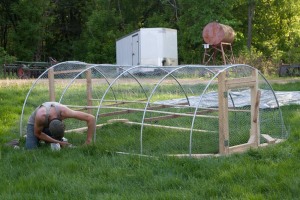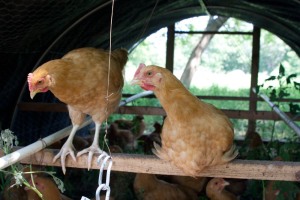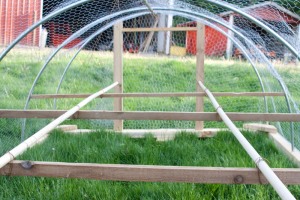 If you’ve ever seen a chicken scratch in the dust or a pig uproot weeds the size of trees, then I don’t have to tell you why these animals shouldn’t be kept on concrete. In terms of animal health and happiness, the benefits of pasturing animals are clear. I don’t mind the reduced feed costs either. But getting pigs and chickens off the concrete doesn’t mean their yard is a pasture—it might start out that way, but in two weeks, or maybe even two days, you’re looking at mud or dust, depending on the weather. Then you have the same high feed costs, bored animals, and a mess as well. The key to pasturing pigs and chickens is mobility.
If you’ve ever seen a chicken scratch in the dust or a pig uproot weeds the size of trees, then I don’t have to tell you why these animals shouldn’t be kept on concrete. In terms of animal health and happiness, the benefits of pasturing animals are clear. I don’t mind the reduced feed costs either. But getting pigs and chickens off the concrete doesn’t mean their yard is a pasture—it might start out that way, but in two weeks, or maybe even two days, you’re looking at mud or dust, depending on the weather. Then you have the same high feed costs, bored animals, and a mess as well. The key to pasturing pigs and chickens is mobility.
 In order to provide the mobility required to keep our chickens and pigs healthy and happy we have been using a combination of electric netting fences and mobile shelters or “chicken tractors.” Here are the designs we’ve come up with after looking at and working with many such mobile homes.
In order to provide the mobility required to keep our chickens and pigs healthy and happy we have been using a combination of electric netting fences and mobile shelters or “chicken tractors.” Here are the designs we’ve come up with after looking at and working with many such mobile homes.
The key to making mobile animal systems work is to make the moving easy. Of course that sounds obvious. But if it’s easy to move, you’ll move your animals more often and keep them happier. For instance, many mobile systems require a tractor to move, which means lots of gate opening and closing and driving around on your pasture. The all-too-common running-gear chicken tractor seems to me to be an expensive way to build a chicken house for 75 birds that’s too heavy to move by yourself without a tractor. I’m also not interested in the supposedly mobile houses that seem to require Hercules to move them—small barn like structures made of two by fours and sheet metal. Worst is building a house with the intention of moving it by hand and then finding out it’s too heavy and pulling it with a tractor—inevitably the house will fall apart under the tractor’s strength.
 Last year we built four mobile chicken tractors, each equipped to raise 50 birds; a mobile pig shelter; and a mobile sheep structure. The keys to our houses are EMT conduit, self-tapping screws, tarps, and the wiggle wire system developed for greenhouses. Rather than mimicking farm buildings with wood and sheet metal, we took our inspiration from green house design.
Last year we built four mobile chicken tractors, each equipped to raise 50 birds; a mobile pig shelter; and a mobile sheep structure. The keys to our houses are EMT conduit, self-tapping screws, tarps, and the wiggle wire system developed for greenhouses. Rather than mimicking farm buildings with wood and sheet metal, we took our inspiration from green house design.
The chicken houses are 6 x 10. Two by four runners are tied together by 6’ conduit hoops made from 10’ EMT. Two by two’s frame a door at each end, and a grid of one by ones hung from the hoops with wire gives the birds a roosting spot (something many pastured birds don’t get). Chicken wire mesh covers the hoops, attached by zip ties. A tarp covers the works, fastened securely in place by the wiggle wire—no ropes, no torn grommets. The house can be pulled with one hand from a pull chord. Still, because the tarp is fastened tight and low, there’s nowhere for the wind to catch. You can build this house for about $100 to house 50 birds.
